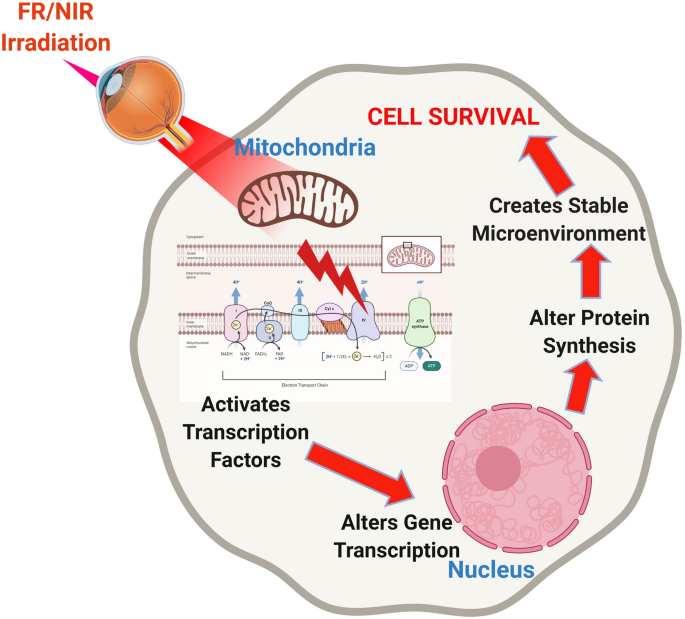The Greatest Guide To Photobiomodulation
Table of ContentsPhotobiomodulation Can Be Fun For EveryoneThe Single Strategy To Use For PhotobiomodulationGetting My Photobiomodulation To WorkNot known Incorrect Statements About Photobiomodulation
Laser therapy is a medical therapy that utilizes focused light to boost a procedure called. During PBM, photons go into the tissue and connect with the cytochrome c complicated within mitochondria. This communication triggers an organic cascade of occasions that results in a rise in mobile metabolism, which can as well as speed up the healing process.There is consensus that the application of a healing dosage of light to damaged or dysfunctional tissue leads to a mobile feedback moderated by mitochondrial mechanisms. Photobiomodulation. Researches have revealed that these modifications can impact discomfort and swelling, in addition to, tissue repair
Adjustments in ATP, reactive oxygen types and nitric oxide comply with light absorption by Cc, O. These effects are redox state and dose reliant.

The Main Principles Of Photobiomodulation
PBM tools have actually been gotten rid of for advertising and marketing by FDA with the Premarket Notification/510( k) process as adjunctive devices for the short-lived alleviation of pain. These clearances were based on the discussion of medical data to sustain such insurance claims (Photobiomodulation). In this therapy, a source of light is positioned near or touching the skin, allowing the light power (photons) to permeate cells where it connects with chromophores found in cells resulting in photophysical and photochemical adjustments that cause changes at the molecular, cellular and tissue degrees of the body
Interestingly, recent research shows that light can improve efficiency in typical tissues and cells. The prospective applications of PBMT are various and are being explored experimentally at the fundamental scientific research, pre-clinical and medical degree. The present scientific uses are for the alleviation of discomfort and inflammation and the therapy of sports injuries.

The treatment specifications and number of sessions needed for PBMT are dependent upon place and reason. PBMT generally needs even more than one treatment for optimum pain relief. It may take a number of treatments for the results to end up being apparent. reports that it can take anywhere from eight to 30 sessions for a treatment to be completely reliable, and some clients discover it needed to undergo therapy two to 4 times weekly.
Photobiomodulation - Questions
Therapy specifications for PBMT were initially established making use of cells artificial insemination and in small animal models. These therapy criteria normally had a reduced irradiance and fluence and functioned well for cutaneous applications. Nonetheless when medical professionals started to make use of PBMT to treat structures that were see post located deeper in the body, they utilized these specifications with negative outcomes.
We currently recognize that these unfavorable researches were due to wrong device and treatment parameters for transcutaneous therapy of much deeper frameworks. Current advances in laser treatment gadgets and even more study into the suitable does have substantially boosted the outcomes of PBMT. For dealing with deep tissues, the wavelength of light used determines the deepness of infiltration right into a tissue.
It is vital that a medical professional makes use of the suitable wavelength of light and criteria to deal with a condition. One wavelength and one set of treatment criteria will not be effective for all problems. Negative side effects have not been reported from the usage of PBMT.
All About Photobiomodulation
In the initial experiment, Dr. Endre Mester, made use of shaved rats and observing just how the laser impacted their ability to grow hair compared to the team that was not receiving LLLT. He found that the team of mice obtaining LLLT were able to grow their hair back faster than the team of computer mice that really did not obtain LLLT (Hoon C, et alia; 2012).
This treatment is called this way to differentiate the distinction between the lasers some professions use to cut (eg. Low-level light therapy is pain-free, non-invasive therapy.
LLLT has a biphasic response, suggesting that reduced dosages are normally attended be more advantageous than greater dosages. That being said, dosages higher or less than the ideal dose doesn't impact (Hoon C, et al; 2012). Therefore, it can be challenging to have researches on LLLT with many parameters.
Some companies integrated the two (LED and laser) to supply a more all-round treatment considering that lasers can permeate much deeper than LED and infrared light (Norman Doidge, The Mind's Method of Healing, 2015). During treatment, the location that is being dealt with is subjected to LED light from a Bio, Flex Laser, which is at 660 nm wavelength, followed by infrared light at 830-840 nm wavelength.